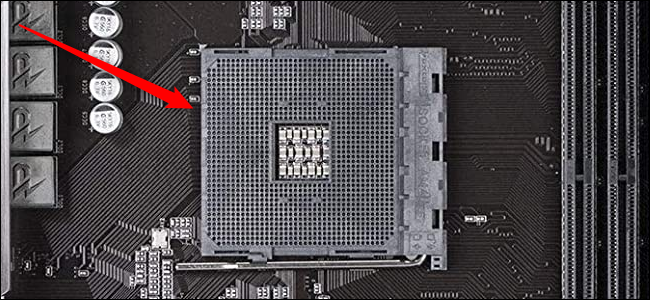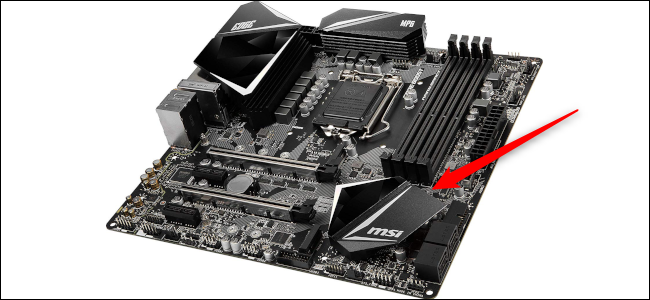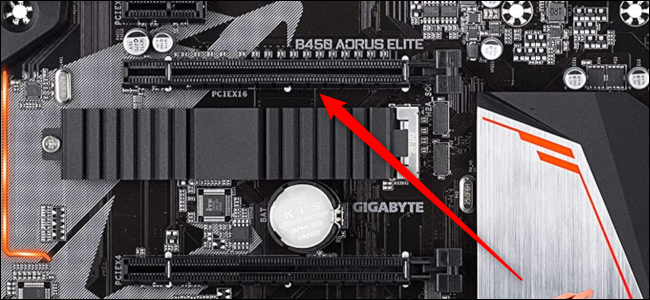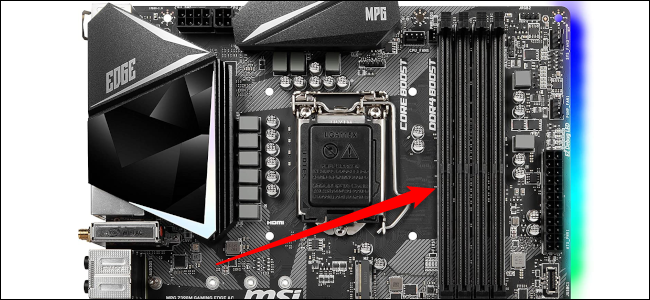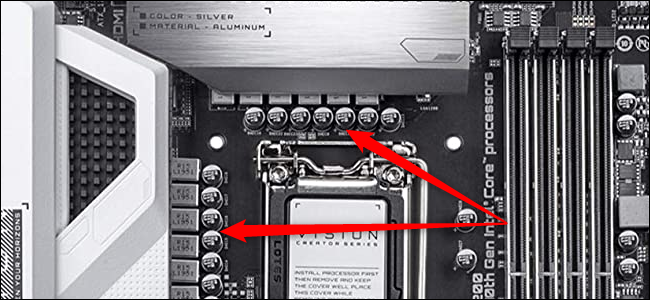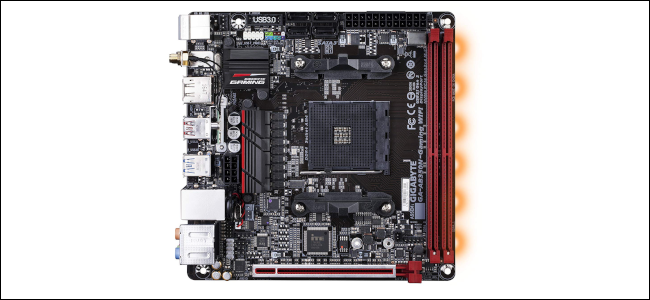The motherboard is where it all starts for the PC. It's the component underlying everything. There are so many different analogies you could draw, but here's our favorite: It's like the computer's nervous system. Its primary job is to send information in the form of electrical signals between the various components in your PC.
Multiple Form Factors
There are multiple form factors of the motherboard, which are all different sizes and suited for different uses. Here's a look at the differences between form factors like ATX, MicroATX, and Mini-ITX if you want more detail on them.
In general, however, most people are looking for an ATX board unless they intend on building a more compact PC. Smaller boards are not recommended for first-time builders, as the smaller space can lead to frustration for novices.
The Essential Stuff
When we look at a bare motherboard, there are some key parts that are immediately noticeable. At one end of the board, we have the CPU socket. That socket is built to fit a specific set of AMD or Intel CPUs. An AMD CPU can never fit in an Intel-compatible board and vice versa. Not only that, but motherboard socket types can change between generations, and one generation of motherboard can be compatible with multiple generations of processors. Thus, an AMD motherboard will not automatically be compatible with any AMD CPU.
To tell whether a motherboard is compatible with your CPU, look to the chipset, which is housed on the end opposite from the CPU socket and covered by a heatsink. It's also commonly referred to as the Southbridge.
We have an explainer on what a chipset is, but briefly, it's the part of the motherboard that acts as the "communications center and traffic controller" for your PC. It figures out if the components you've slotted into your PC are compatible with it, and controls input and output duties for components that don't communicate directly with the CPU, such as USB ports and SATA controllers.
Multiple chipsets can be compatible with a specific generation of CPU, and the chipsets are usually divvied up into high-end, budget, and entry-level board types. Recent AMD chipsets at the time of writing include the X570, for example, the more budget-focused B550, and the entry-level A520.
After the CPU socket and chipset, we have all the various slots on a PC. Below the CPU are the PCIe slots for graphics cards and other add-in cards such as sound cards, TV tuner cards, and Wi-Fi and Bluetooth cards (for motherboards without built-in wireless connectivity).
The graphics card uses what's called the x16 slot. This is a PCIe slot with 16 lanes for moving data between the graphics card and the CPU. The other slots typically have fewer than 16 lanes, even though some can be the same size as the x16.
Meanwhile, right next to the CPU socket are another set of slots for RAM modules. There are typically two or four RAM slots depending on the size and price level of your motherboard. Then, around the edges of the board, you have SATA connectors for hard drives and 2.5-inch SSDs, and a 24-pin power delivery port that connects to the PC's power supply.
Finally, we have a number of other power delivery units called headers that have pins sticking out of them. These are for items like the USB ports, front panel audio (It's the 3.5mm jack at the front of your PC case.), RGB lighting, and so on. The headers are typically marked, making it easy to know which cables connect to each. Up near the CPU socket, there's also a smaller power connector for the CPU itself.
Those are the key parts of the motherboard that most first-time PC builders will deal with. Though sometimes, you may have to understand what the CMOS battery is (It's that watch battery on the motherboard.) as well as jumpers.
The VRM
Beyond the basic features, one subject motherboard reviewers and enthusiasts love to talk about is the voltage regulator module or VRM. The VRM is not a single part, but a collection of parts working together. A high-quality VRM is a key consideration, since it factors into the motherboard's life expectancy---not to mention the motherboard's ability to keep working under the strain of overclocking.
To supply power to the CPU, the voltage coming out of the power supply needs to step down to something around 1.2 to 1.3 volts. It can go higher or lower than this depending on how power-hungry the CPU is and whether it's being overclocked. To step down the power for the CPU, the motherboard relies on its VRM. The VRM is made up of three primary components: capacitors, chokes, and MOSFETs. There is also a pulse width modulator (PWM) as well as driver integrated circuits, but when people talk about VRMs, they are usually discussing the three primary components.
Capacitors are those cylindrical items all over the motherboard. Capacitors can hold a charge and help smooth or filter the voltage delivered to components to protect against surges. Having good quality capacitors on a motherboard is important, since your system may cease to work properly if they blow. Capacitors can be replaced when they do go bad, though sometimes, a full replacement is the better option, especially if your motherboard is on the older side.
If you look around the CPU socket on a motherboard, you'll notice there's quite a collection of capacitors there. They are usually standing in front of or close to these little cube-shaped items called chokes. The chokes are there to help stabilize the voltage, and behind them are these small chips called MOSFETs (metal-oxide-semiconductor field-effect transistors). On high-quality boards, MOSFETs are usually hidden from view under a heatsink behind the chokes. On other boards, say something low budget aimed at Pentium CPUs and Core i3 CPUs, the MOSFETs may be visible near the chokes. In general, you want a board with a heatsink over the MOSFETs, since they can get very hot.
The MOSFETs help deliver the voltage required by the CPU. Then the chokes and the capacitors work to stabilize that power and protect against spikes. These parts team up to create what are called phases, which are made up of two MOSFETs, a choke, and a capacitor. The more phases a motherboard has, the cleaner and more stable the flow, and the more potential power can be delivered to the CPU socket when overclocking.
You can sometimes tell how many phases a board has based on the number of chokes on the motherboard. A board with six chokes would have six phases, for example, but it's not always that simple.
Some board makers add more chokes per phase, thereby making it look like there are more phases than there actually are. This is not necessarily a devious move, as extra components can help share the workload, though it's not as good as having additional phases.
Gigabyte's B450 Aorus Elite v1, for example, has 11 chokes, but actually uses a 4 + 3 design where four phases deliver power to the CPU cores and have double chokes on each of those phases. Then there are another three phases that deliver power to other parts, such as the processor's integrated GPU (if applicable) or I/O die.
Worrying about VRMs and phases is not necessary if you're not overclocking. A reasonably good VRM is still important, but the biggest concern about the VRM is providing clean power and having durable components that can stand up to the pressure of overclocking.
The best way to find out about VRM quality is to read reviews. A more expensive board does not necessarily mean a higher quality VRM. It's better to consult reviews before buying in order to get independent assessments of the strength of a board's VRM.
Motherboard Shopping
We're not going to make suggestions here about the model of motherboard you should buy, since there are so many variables that go into it---plus, motherboard models can undergo several revisions.
The best we can do is offer some basic guidance on how to choose a motherboard, and leave you to do your own research. The first thing to consider is the features. Do you plan to have a PC with a graphics card, a sound card, space for a future Wi-Fi adapter, and maybe a bunch of other expansion cards? Then you'll need something with enough PCIe slots to accommodate all of that.
Does it have an M.2 slot for an NVMe SSD? You'll definitely want at least one of these, since NVMe drives are so much faster than 2.5-inch SSDs and hard drives.
What about Wi-Fi and Bluetooth? Do you want those built into the motherboard, or are you relying on the aforementioned PCIe expansion card?
Don't forget the RAM slots and the maximum memory capacity they allow for. This is critical, especially if you're trying to future-proof your rig as much as possible.
Then you want to make sure that it has enough SATA ports for expansion drives, and don't forget RGB. LED lighting can look really nice, and it's easier to consider this now rather than after the computer is put together.
Once you know what you want for features, it's easier to narrow down your choices. Then, when you have a shortlist of contenders, consider VRM quality (especially if you're overclocking) by checking out reviews.
These are just some general tips, but the basic rule is this: Get the features you want that are within your price range, and then pay attention to issues such as VRM quality if you plan on overclocking.
Conclusion
The motherboard isn't as exciting as picking up an overpowered CPU or an incredible graphics card capable of pumping out high frame rates at 4K. Nevertheless, a good quality motherboard with the features you need is a key part of your PC, and is especially important when it comes to overclocking. Doing a little bit of research to get the right board will go a long way toward creating a rocking PC build.


